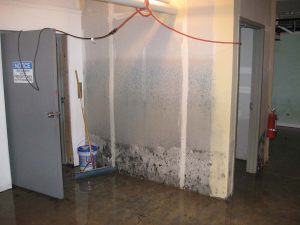Earlier this fall, the entire country watched as hurricanes Harvey, Irma and Maria caused widespread destruction across Texas, Florida, the Caribbean and Puerto Rico. As I followed the media coverage leading up to and following these storms, my thoughts of course turned to the rebuilding process and post-hurricane construction work ahead for these communities. As a national commercial construction firm offering emergency commercial facility maintenance and repair services, we know it’s never easy to deal with damage to any property, much less on the scale of what a major natural disaster can cause. We also understand how important it is to have a commercial facility disaster plan in place ahead of time.
While hopefully most of us will never experience firsthand the result of a category 4 or 5 hurricane, these recent storms offer some good reminders to all commercial property owners and tenants about preparing for serious weather-related events that could potentially strike in their area and cause commercial facility damage. In fact, prior to Hurricane Irma, several Florida-based clients of Englewood’s facility management division asked us to be on standby. Luckily, none of these clients sustained significant damage and our services were not needed – but the considerations that came up as we prepared to be of assistance are relevant for any commercial property owner, landlord or tenant. Here are some important points to keep in mind for developing an emergency facility maintenance and repair plan:

As part of preparation for winter weather events such as blizzards or extreme cold, commercial property managers should ensure vacant spaces are winterized in order to avoid flooding and water damage from frozen/burst pipes.
1. Make the Most of Advance Notice
While not every natural disaster can be predicted, weather-related emergencies such as hurricanes and winter storms are typically forecast at least a few days in advance. Commercial property operators can use that time to first and foremost ensure they have an evacuation plan in place and employees, tenants and customers are safe – but also to take commercial construction preventative maintenance steps to avoid or minimize storm damage, or enlist their facility maintenance contractor to handle those tasks for them:
Hurricane, tropical storm or high wind event
• Board up windows and doors
• Secure any areas of the property that are vulnerable to sustained winds or gusts
Blizzard, ice storm or extreme cold snap
• Check that all vacant spaces are fully winterized to avoid frozen and burst pipes
• If appropriate, bring in temporary heating to run during sub-zero temperatures
• Ensure all window and door seals are intact
Finally, property managers and owners should follow the lead of our Florida clients and reach out to a reputable construction and facility maintenance firm in advance of a weather emergency to let them know they may need assistance – and secure their spot at the top of the contractor’s list when recovery and cleanup efforts begins.
2. Prepare for Limited Resources
As we planned to provide immediate assistance to our clients in Florida, we were sure to plan for resources unlikely to be available in the aftermath of a storm – namely, electricity, construction materials and manpower.
We knew lumber in the area would be scarce due to the boarding up of property before the hurricane made landfall, and local home improvement stores probably wouldn’t be open in the immediate aftermath of the storm anyway. And besides anticipating widespread power outages that go hand-in-hand with major storms, we also knew local subcontractors would be in short supply, since any local laborers not dealing with storm damage to their own personal property were likely to be in extremely high demand.
Since Englewood maintains a database of trusted national subcontractor partners, one advantage we offer clients in responding to a natural disaster or extreme weather is the ability to tap into our network to bring in labor and supplies from outside the impacted area. In preparation for Hurricane Irma, we had several of our preferred subcontractor partners from the neighboring region on standby to truck in workers, lumber supplies, equipment and generators.
3. Let the Recovery Begin
Once a weather-related disaster is over, it’s time to take stock of damage and begin repairs. One reminder we always give clients is that if damage to a commercial facility is significant enough to make an insurance claim, they should always have their insurance company come out to document the damage before making any repairs. It is certainly fine to take immediate steps to stabilize and secure a commercial property in the aftermath of a storm, such as boarding up broken windows or dealing with urgent safety concerns, but the insurance company will need the opportunity to do its own assessment in order to process a claim.
Property owners – including both commercial and residential – should also be cautious of “pickup truck” contractors who inevitably descend in regions impacted by big storms. The concern with these storm chasers is they are often untraceable and disappear after completing a job, meaning there is no recourse if there are issues with the work. As with any construction project, it is important to check the references and reputation of any construction firm you hire for disaster recovery work and, if possible, use a contractor you’ve had a positive experience with previously.
That last point also highlights the peace of mind that comes with enlisting the ongoing services of a commercial facility maintenance and management contractor. Not only is that trusted partner there as a single point of contact for any commercial facility maintenance need that arises, from fixing a leaky roof to regular HVAC servicing, but they are also just a phone call away when the unexpected happens. If you’d like to find out more about creating a facility maintenance and management program for your property, give us a call.
Tel: 847-233-9200 x712
Questions? Comments?
You can reach me at CTaylor@eci.build
www.EnglewoodConstruction.com
from Hard Hat Chat http://commercialconstructionblog.com/emergency-commercial-facility-disaster-planning-3-takeaways-from-recent-hurricanes/
via Hard Hat Chat
No comments:
Post a Comment